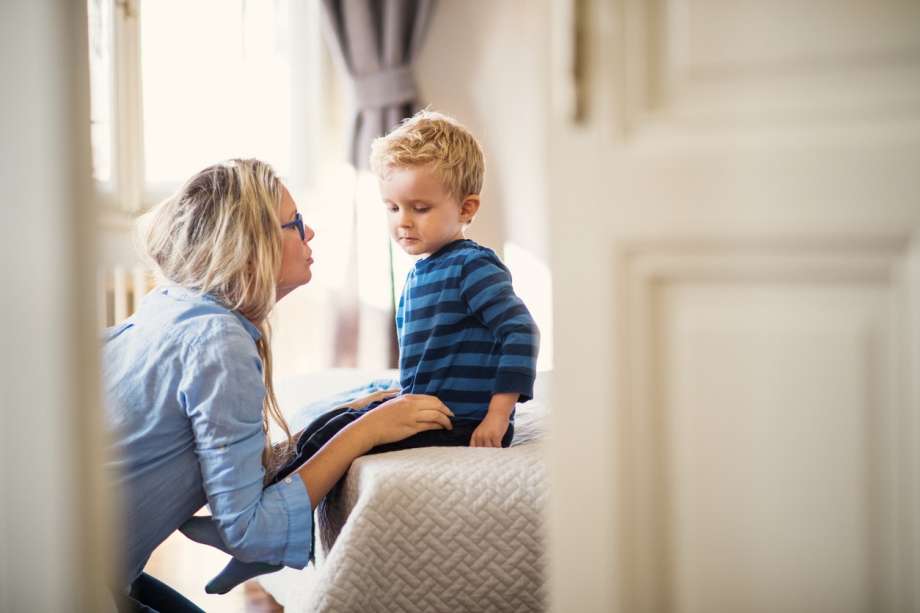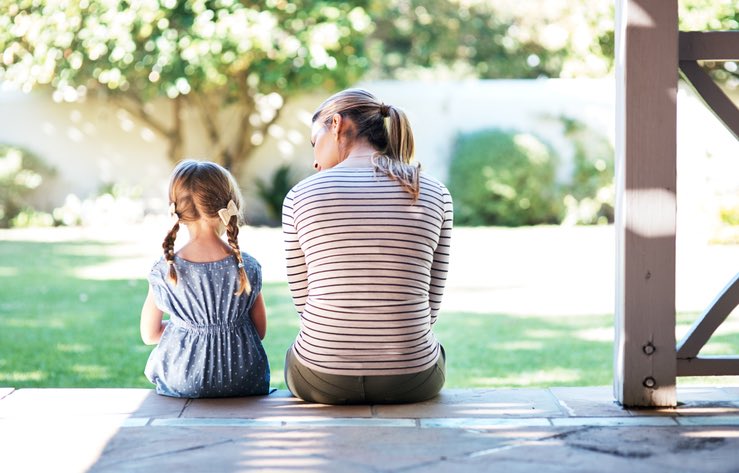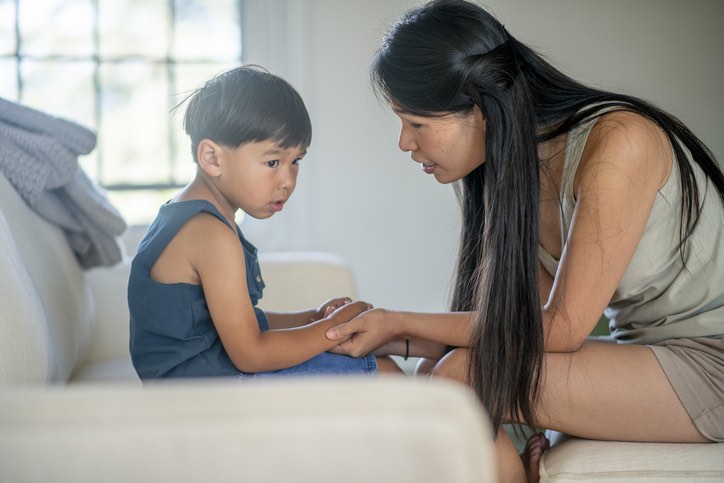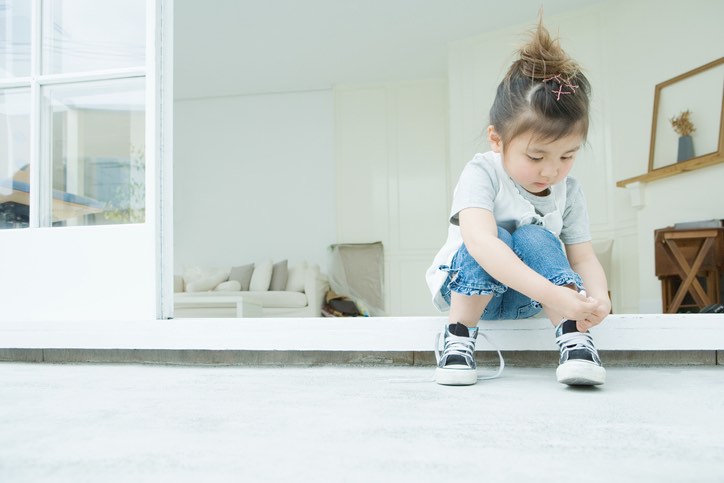How to Build Healthy Boundaries With Young Children

Contrary to popular belief, boundaries are first and foremost for you, not for the benefit of others. This presents quite the parenting dilemma, especially when mainstream parenting suggests that you should put your child first. If we dare to curiously observe boundaries from a ‘me first, then you’ perspective, we are then able to redefine what boundaries are and create a foundation for our toddlers to first identify boundaries as an ongoing practice, then apply their understanding through setting healthy boundaries with others.
From this approach, we embrace setting rules about boundaries from a parent-first position, supporting the caregiver to model clear boundaries, and allowing the following question to take shape: who am I, and who are you?

As parents, it’s challenging to separate our needs from those of our young children, yet the benefits of setting clear boundaries for all family members are distinct. Dr. Michele Borba, an educational psychologist, shares that setting boundaries is a way to express love toward our children, and teach them to set their own limits, both physically and emotionally. Furthermore, boundaries show children how to protect themselves and establish boundaries as they continue to develop.
Setting healthy boundaries moves beyond command statements such as “no hitting,” yet as parents, it’s common to question if our toddlers truly understand boundaries. The short answer is yes. Age two is a critical period for children’s brain development. During this time, the connection between brain cells is doubled compared to that of an adult. Connections are where learning develops, so twice as many connections translate to a brain that’s learning efficiently (at a fast rate).
While science backs the notion that our toddlers are learning at an accelerated rate, soaking in what they observe, as caregivers of these bite-size humans, it can be challenging to remain in a state of curiosity when developmentally they are meeting new milestones; talking, moving, exploring and testing limits with excited energy.
I invite you to move beyond the common literature on parenting tips that address the same-old notions on boundaries; setting limits, effective communication and follow through. Yes, these concepts are key to healthy relationships, and you likely already know that.
It’s time to welcome a parent-first perspective. Here are 7 ways to build healthy boundaries with your toddler that will last a lifetime.
7 Ways to Build Healthy Boundaries with Young Children

1. Align Your Core Values with Actions
Values are foundational beliefs that guide how we behave. They influence how we embrace others, and they define the core of who we are, our sense of self. If our actions are in alignment with our core values, we can start to understand what deserves our attention, and what doesn’t.
Start by asking yourself, what’s important to the relationship right now? What’s important will vary; some days it could be uninterrupted one-on-one time or a mental health break to reset from a hectic routine. If we’re clear and honest about what’s important, we not only establish our next actions – we also create mindful boundaries around how we choose to engage our toddler and we permissively define what’s best for the relationship.
Observational learning is one way to engage your toddler with boundary setting. Observational learning is a form of learning that happens through watching and imitating the behaviors of others, and it begins at birth. This suggests two things; it’s never too early to start teaching boundaries, and your behavior becomes a consistent and powerful tool to guide and influence your child – you are their best role model.
Take time to share what’s important to the relationship with your toddler. Through speaking your intention out loud, you give boundaries an opportunity to meet your values, teaching your child how to both prioritize and action their intention.
2. Practice Reciprocity

Boundaries require an exchange of information and they provide opportunities to share clear expectations of what feels okay and what doesn’t. For parents or caregivers, physical boundaries are often a natural place to start, yet I encourage you to also explore other boundary categories such as emotions, time, and money.
Reciprocity requires communication. While it may seem that your toddler doesn’t understand what you say, the truth is they comprehend more than they can verbally express. Language development flourishes during the toddler years – toddlers are learning new words daily, imitating much of what they hear, and start forming short phrases by placing words together.
This question, “Is it okay if…?”, is a great starting point. It helps your child begin to define what boundaries will support their overall well-being. Don’t assume; things that feel comfortable for you may not feel comfortable for your toddler, and vice versa. Remember to model your own comforts and discomforts too. This helps your child to realize that boundaries look different for everyone, further creating a working blueprint to empathize with the needs of others.
3. Honor Yourself
This is where we cue the flight attendant to remind you, “put your oxygen mask on first.” As parents, we’ve gotten accustomed to an almost reckless selflessness; overextending ourselves and saying yes, when we really need to say no.
Honoring yourself is about prioritizing and investing in your well-being first. It’s a conscious decision to draw boundaries around how you choose to spend your time. Take inventory, how often are you making self-care a consistent practice versus waiting until overwhelmingness and depletion hit dangerous levels, only to fill your cup just enough with a single self-care practice?
Brené Brown, an American researcher and author, found that people who were able to set boundaries with others to focus on themselves were also the most loving and compassionate people.
Only by creating a slight gap, a slight border between yourself and others will you be able to support and empathize with them at any given time of need, so that their problems do not become your own. If you lack boundaries with others too much in one direction, ie, you’re too invested, your level of empathy may become so extreme that you actually make that person’s challenge all about you. This is why those who are able to set necessary boundaries are able to be the most compassionate because there’s enough space between themselves and the problem to recognize that it is not theirs. Only when we realize this can we help others and truly empathize.
In this way, by ‘daring’ to set boundaries, we give ourselves the opportunity to become the most loving and compassionate people we can possibly be.
The same thinking can be applied to your own children, even if they are only young. If you do not set any boundaries between yourself and your child, you could risk becoming overly anxious about their own challenges, and accidentally express this anxiety outwards – implying to your toddler that you are the one that needs looking after. This doesn’t set the path for a healthy relationship between parent and child.
4. Foster Independence

The toddler years mark a transition; increasing independence is taking place, yet they’re also not fully self-sufficient yet. Independence is supported by an “I can do this for myself” attitude and interdependence from a toddler should look like an ebb and flow between completing a task on their own and needing support from others.
Let me ask you, what are you doing for your toddler that they can do for themselves? As you start to formulate a list, think about the reasons you engage in doing or taking over. Is it difficult to see your toddler frustrated? Is it faster to do it yourself?
When we undermine our child’s capacity to do things for themselves, we’re hijacking their learning process and child development, and this is a breach of boundaries. We’re also sending an underlying message; I don’t trust your abilities. Take time to identify what activities require your help, and those that don’t, creating a boundary that acknowledges and honors your toddler’s growing independence.
5. Observe Body Language
In addition to the ability to say “no,” boundaries require you to identify your own feelings. This isn’t just about being self-aware; it’s about recognizing the physical sensations that arise in your body.
Quite simply, when a firm boundary is aligned, it will feel good. If your body signals discomfort, check in with yourself. Are you looking for approval from others? Do you believe that your feelings are valid? Did you hold your ground, or did you bend your limits? If a bend took place, what prompted that change?
The limbic system is the part of the brain that organizes feelings and emotions. This emotional part of the brain is maturing rapidly during the toddler years and this is where self-expression, reactions, and communicating needs are expressed.
Labeling your child’s feelings or describing how your child feels based on observable cues such as facial expressions or body language are effective ways for toddlers to learn feelings, an essential tool for boundary setting. Get creative, books, music and imaginative play are all great tools to incorporate feelings into your everyday life.
6. Learn the Difference Between Development and Limit Testing

While we foundationally know that testing boundaries is a normal part of toddlerhood, it can be hard, as a parent, to remember this in a moment where our patience is tested.
Toddlers are ego-centric, meaning they’re self-focused. Ego-centric thinking supports their developing independence. So when children are criticized or lack the ability to assert their sense of personal control, they can start to feel inadequate. Inadequacy can morph into overdependence, self-doubt, and shame.
So, the next time your patience is tested, ask yourself, is my toddler actively testing my limits and purposefully enacting frustrating behavior, or are they simply developing their independence? Being able to differentiate between the two will help you with appropriate boundary setting.
7. Practice Self-Control
There’s a natural frustration that happens when we assert a boundary, and the receiving party doesn’t respect it. Malicious or not, the harsh reality is, voicing a limit doesn’t mean that it will be respected or accommodated.
This truth is a necessary part of teaching boundaries. It’s easy to get caught in negotiating our boundaries, thinking that if we compromise our parameters or communicate our needs differently, the other person will respond agreeably. This applies to all ages and stages, and all relationships, but it can be especially hard not to give into renegotiating your boundaries when you’ve got a screaming toddler at your feet.
As tough as it is, resist jeopardizing your boundaries. Re-negotiating your boundaries is a denial of your own needs. It’s a choice to bypass your needs, ultimately saying “yes” to the priorities of others, instead of practicing self-control. When we redefine boundaries as a choice, we create accountability for ourselves.
Give your toddler choices and follow through. This supports their growing independence and honors their opinion. So, what happens when our toddler is unhappy with the outcome? It becomes a teachable moment to explore the relationship between actions and consequences, problem-solving, and taking responsibility for our choices.
Boundaries are complex, and while it may seem as though toddlers don’t understand the true meaning of limit setting, their rapidly developing brain tells us otherwise. With their growing independence at the forefront, the toddler stage is a perfect time to teach developmentally appropriate tools that will solidify a strong skill set for understanding and asserting boundaries for years to come.
And don’t forget the underlying premise, boundaries start with you.
---
Christina Trujillo Sieren, is an author, speaker, and mom of two. Christina is a licensed psychotherapist with a private practice specializing in high-risk adolescents and families. Her focus is on helping people choose their “edge” and embrace the unknown that lies ahead. She is the Founder and Lead Coach of Unapparent Parenting, INC., where she provides coaching to parents of teens. Christina supports parents to question mainstream parenting concepts and embrace the messiest of moments, daring parents to re-define their most authentic parenting blueprint from the inside out. Christina is the author of Parenting Teen Girls: A Positive Parenting Approach to Raising Health, Independent Daughters. For more information and to connect with Christina, visit www.christinasieren.com.